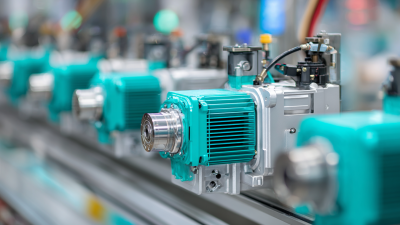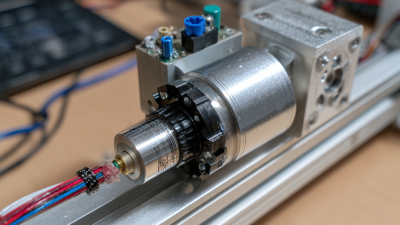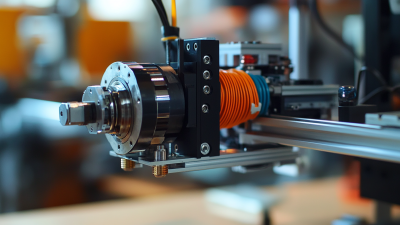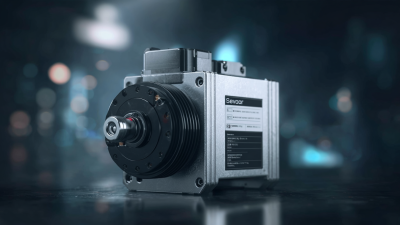
-
Home
-
Products
-
Application
-
Documents
-
News
-
Blog
-
Blog
-
Sinsegye
Leave Your Message
-
Wechat OA

-
 Baijia Hao
Baijia Hao



 Baijia Hao
Baijia Hao

In the rapidly advancing field of automation and robotics, optimizing the performance of Servo Motor Drives has become paramount. According to a recent report by Allied Market Research, the global servo motor and drive market is projected to reach $13.1 billion by 2027, reflecting a compound annual growth rate (CAGR) of 6.8% from 2020. This robust growth is driven by the increasing demand for precision motion control in industrial applications such as CNC machinery, 3D printing, and packaging. To harness the full potential of Servo Motor Drives, engineers and technicians must adopt effective optimization strategies that enhance efficiency, reduce energy consumption, and improve overall system reliability.

This article outlines five essential tips for maximizing performance and ensuring that your Servo Motor Drive operates at its peak capabilities.
Understanding the fundamentals of servo motor drive technology is crucial for optimizing performance in various applications, especially in the context of advanced defense systems and industrial automation. Servo motors are designed to provide precise control of angular or linear position, velocity, and acceleration, making them indispensable in robotics, CNC machinery, and aerospace applications. According to recent reports from industry experts, the global servo motor market is projected to reach $9.5 billion by 2025, driven by advancements in automation and a surge in demand for high-performance machinery.
In the evolving landscape of defense technology, initiatives such as the UK's Ministry of Defence's recent outline of cutting-edge projects emphasize the need for robust servo systems. The emphasis on integrating next-generation technologies to address long-term defense challenges corresponds with the growing importance of servo drive optimization. By focusing on critical parameters such as feedback control, thermal management, and system integration, industries can substantially enhance the efficiency and reliability of their servo motor drives, thereby ensuring superior operational capabilities. This strategic approach resonates with the goals outlined in the 14th Five-Year Plan of China, which aims to bolster technological advancements in various sectors, aligning with global trends towards automation and precision in defense mechanisms.
Optimizing servo motor performance relies heavily on understanding and adjusting several key parameters. One of the most critical aspects is the tuning of the PID (Proportional, Integral, Derivative) controller. Proper tuning ensures that the motor responds accurately and quickly to commands, minimizing overshoot and settling time. Fine-tuning the PID values can significantly enhance the stability and speed of the system, making it paramount to perform this step meticulously.
Another essential parameter is the selection of the feedback device. The type of encoder used, whether incremental or absolute, can greatly influence performance. High-resolution encoders typically provide more precise feedback, which is crucial for applications requiring fine control. Additionally, setting the correct gains and limits based on the application’s load characteristics can prevent performance degradation and enhance the overall efficiency of the servo drive system. By carefully considering these factors, engineers can significantly enhance the performance of their servo motor drives.
| Parameter | Optimal Range | Impact on Performance | Recommended Action |
|---|---|---|---|
| Voltage | 220V - 240V | Inadequate voltage can lead to overheating and insufficient torque | Ensure power supply is within the specified range |
| Speed | 1000 - 3000 RPM | Too high or too low speeds can affect accuracy | Adjust according to load requirements |
| Feedback Type | Incremental or Absolute | Feedback quality affects position accuracy | Choose feedback suitable for application needs |
| Acceleration | 500 - 1000 rad/s² | Excessive acceleration can cause mechanical stress | Set optimal acceleration for system stability |
| Temperature | -10°C to 60°C | High temperatures can reduce motor lifespan | Monitor and manage operating temperature |
 When it comes to fine-tuning servo motor drive settings, precision is key. One of the first techniques to consider is adjusting the proportional gain. This setting determines how aggressively the servo motor reacts to errors in position or speed. By carefully increasing or decreasing the proportional gain, users can achieve a balance that minimizes overshoot while maintaining responsive performance. It’s crucial to test these adjustments under various loads to ensure the motor behaves consistently across different operating conditions.
When it comes to fine-tuning servo motor drive settings, precision is key. One of the first techniques to consider is adjusting the proportional gain. This setting determines how aggressively the servo motor reacts to errors in position or speed. By carefully increasing or decreasing the proportional gain, users can achieve a balance that minimizes overshoot while maintaining responsive performance. It’s crucial to test these adjustments under various loads to ensure the motor behaves consistently across different operating conditions.
Another effective technique is to optimize the integral and derivative settings in the PID control loop. The integral component helps eliminate steady-state error, making it vital for applications requiring high precision. Meanwhile, the derivative component dampens oscillations and improves stability during rapid changes in load or direction. Fine-tuning these values often involves iterative testing, where small adjustments lead to significant improvements in overall drive performance, allowing the servo motor to operate smoothly and efficiently across a range of tasks.
Servo motor drive performance is critical in industrial automation, yet several challenges can impede optimal functioning. Common issues include overheating, inadequate feedback control, and improper sizing of servo motors. Overheating can lead to system failures; thus, engineers should ensure proper cooling methods, such as heat sinks or active cooling solutions, are in place. Additionally, enhancing feedback control systems improves response times and accuracy, ensuring the servo drives operate within their designated performance parameters.
Another significant challenge is selecting the right servo motor for the application. Engineers must evaluate factors like torque requirements, speed, and mounting options before making a decision. Incorrect sizing can result in inefficient operation or even system damage. Implementing mechatronic subsystems can address these issues by providing a comprehensive solution that integrates various elements, making it easier to manage performance and reliability. By tackling these common challenges with targeted solutions, engineers can enhance the performance and lifespan of servo motor drives in industrial settings.

Maintaining servo systems is crucial for ensuring optimal performance and longevity. Regular inspections can help identify potential issues before they escalate. Begin by checking all connections and wiring for signs of wear or damage, as these can lead to erratic behavior or complete system failure. Additionally, ensure that the motor and drive are free from dust and debris that can interfere with operation.
Another key practice is the routine lubrication of moving parts, which minimizes friction and wear. Use the manufacturer-recommended lubricants to avoid damaging components. Additionally, monitoring the temperature of the servo drive is essential; excessive heat can indicate problems and shorten the lifespan of the motor. Keeping an eye on these factors can help maintain efficiency and performance.
When troubleshooting, it’s vital to have a systematic approach. Start by assessing whether the software settings are correct and ensure that feedback devices are functioning properly. A misconfiguration can lead to inaccurate positioning or response times. Employing diagnostic tools can aid in pinpointing issues quickly, allowing for faster resolutions and reduced downtime. By focusing on these best practices, you can enhance the reliability and performance of your servo systems.
This chart illustrates the importance rating of five essential tips for optimizing servo motor drive performance, rated on a scale from 1 to 10. Regular maintenance and software updates are rated as the most critical practices, thereby emphasizing their necessity for effective servo system management.





